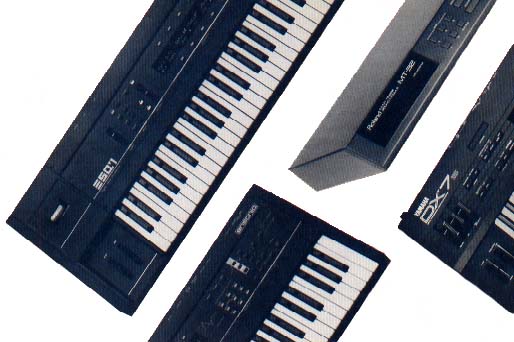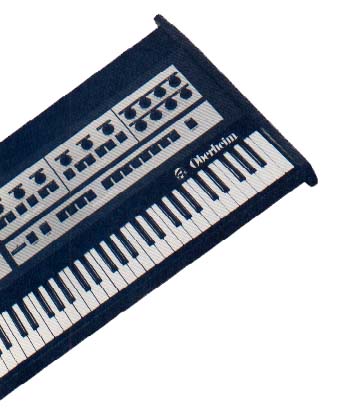
Making MIDI Affordable
BY RICK DAVIES
Are yesterday's breakthroughs today's classics or just garage-sale bargains? With the rising cost of synthesizers and samplers, setting up a personal MIDI studio can be expensive. Rick Davies, musician and MIDI consultant, presents a few things to look for when shopping for MIDI hardware.
Whether you applaud or curse the evolution of commercial synthesizers, there's no denying its hard to keep track of every keyboard module on the market. Some synths are worth buying new; others are worth waiting for.
In the following article, I offer some ideas on what to look for when you're out shopping for a synth or sampler to accompany your ST. I've also included a section on samplers. The article does assume some knowledge of synthesizers and samplers on the readers part. (For two excellent introductory articles on setting up your own MIDI studio, see Jan Paul Moorhead's "Synths, Samplers and Drums" and Jim Pierson-Perry's "Home Recording on a Budget," both in START Special Issue #2.)
Before You Buy
Before you get talked into blowing all your hard-earned cash on the latest "state-of-the-art" equipment, ask yourself if you really need it. Multi-timbral effects, full MIDI implementations, Mode 4, 12 bits and other buzz words don't mean a thing if you have no use for them. Some questions to consider:
Would you be better of with a modest setup that sounds great or a flexible setup that gives you only so-so sounds? If you want to sketch out arrangements with a multi-timbral synth, then your path is set. On the other hand, you might be more comfortable composing with a synth that's easier to operate.
What if you plan to end up in a multi-track studio? Then you'd be better off picking up one synth capable of a wide range of useful sounds, rather than a multi-timbral one that wows you with what it can do all at once.
Do you plan to do multi-part sequencing? Then you need a synth that operates in MIDI Mode 4 (otherwise known as Mono Mode). Even if the synth isn't multi-timbral, Mode 4 usually allows each voice to be played as an independent synthesizer, with its own pitch bend and modulation. This becomes extremely important for sequencing. The TX81Z and FB01 by Yamaha provide excellent examples of Mode 4 operation.
New or Used?
Once you consider the factors mentioned above, you might just decide to wait until you can afford a new Ensoniq ESQ1, Roland D10 or Korg M1 and save yourself the anxiety of not knowing whether you made a mistake by buying second-hand. But before you decide either way, however, consider carefully what your new synth of choice may be worth in a year or two. Also, figure out whether or not you're going to extract that much more performance out of a new synth than you would out of a used one.
Second-hand package systems can often outperform the all-in-ones. For example, layering two "simple" synths with MIDI makes it easy to try out different sound blends and the synths can be treated independently with equalization and effects (if you have any).
On the other hand you'll also need to organize two sets of patches. It's up to you to decided whether the difference justifies the higher price.
Where do you find used equipment? Drop into your local music stores, check the "for sale" section of your local newspaper and the classified ads in Keyboard and Electronic Musician magazine. All of these are good sources of sweet musical deals.

More Buying Tips
Before you go out shopping, learn to interpret MIDI implementation charts. Although these charts don't reflect such aspects as how easy it is do multi-timbral sequencing or how fast that particular synth responds to MIDI data, they do indicate approximately how much MIDI the synth has.
Look for MIDI Thru ports on older synths. MIDI Thru ports allow several instruments to play off the same stream of MIDI messages without adding switchers and splitters. If your system is still in its infancy, then you can probably get by without a Thru for now. It doesn't take long to build up a multi-instrument system, so think carefully about how much you're really saving by buying a no-Thru instrument.
Get a suitable "master" synth controller if you don't already have one. If you're shopping for a main keyboard, then try to get one with velocity and/or after-touch sensitivity. This is what continues to make the Yamaha DX7 a good bet and why the classics continue to get passed up by the first-time synth player.
Some equipment limitations, such as the Yamaha DX7's ability to transmit only on MIDI channel 1, can be compensated for by appropriate music software that allows MIDI echoing on multiple channels. The right software also allows sequence tracks to be "channelized," so don't let MIDI capability be the only deciding factor.
Synthesizers
There are a few synths everyone should consider purchasing at some point in their life: the original Yamaha DX7, TX81Z and FB01, the Roland MT32 and the Casio CZ101. There have been plenty of other modules and keyboard in between each of these and bigger and littler brothers are sure to follow. Nonetheless, these instruments continue to be good value.
The DX7, having been discontinued to make way for the DX711 and DX7S, has dropped in resale price but is still a great buy for under $1000. It is, how ever not multi-timbral. Also, without the Grey Matter Response E! board, the DX7 transmits on channel 1 only. The E! board earns every cent of its $299 retail price.
Now unless you want to pay bigger bucks for the TX816 or TX802 system, with their virtually nonexistent front panels, you'd better look at the FB01 or TX81Z, both of which are eight-voice, multi-timbral, four-operator jobs. They aren't easy to program and don't have quite the scope of sound that the DX7 has, but can produce nice layered textures.
The MT32 uses LA synthesis and is in the low end of Roland's D series. The MT32's sound is much simpler than the D-50's, but it makes up for this limitation by being multi-timbral. But the big problem with the MT32 is that it has no battery back-up, which essentially turns it into a preset instrument unless you have patch librarian life-support. On the plus side--the MT32's presets include many useful sounds and the built-in percussion samples make it a handy first module.
The Casio CZ101 is still a great way to get started for some pretty simple reasons: it has eight voices (although better sounds reduce it to four-voice), it's multi-timbral, has a keyboard (albeit very small) and can be purchased for around $200. There are plenty of patch editor/librarians for the CZ101, thousands of sounds available through dozens of synth patch companies and it sounds quite good for what it is. I've heard live recordings made with no more than a CZ101 and a drum machine and have been very impressed. There are no independent outputs, but if you're careful, you can strike a good mix with judicious selection of sounds and thoughtful orchestration. Considering the CZ101 was the first in the phase-distortion synthesis series, it set quite an example for its descendants.
Classic Synths
The reliability of classic synthesizers is worth keeping in mind because they generally contain an incredible number of components compared to the VLSI wonder-synths of recent years. I like to compare these classic instruments to British sports cars because you have to be prepared to pamper them a bit if you want to keep them running well and that may not be cheap.
I want to focus now on the instruments that were around before MIDI appeared and were later offered with MIDI retrofits. I'm referring to the Oberheim OBX and Sequential Prophet synths, which can be found for around $1,000.
I have a real soft spot for synths with full-blown front panels featuring dozens of knobs and switches and wish this type of user interface would experience a renaissance ("Fat chance!" shout the critics). I wince whenever I hear of a Prophet 10 with built-in poly sequencers and MIDI selling for just $500.
Samplers
As far as samplers go, the real bargains are in the used market. If you do buy a used sampler be sure it has an analog filter included. Analog filters help condition samples into more expressive sound sources. Also, I've heard a lot of people say they'd rather wait for 16-bit samplers to come out in the $1,000 range rather than buy anything currently available. They'll have a long wait because sample memory chips haven't dropped in price--they've risen.
The original Ensoniq Mirage is still worth a look. The new Mirage DSK retails at $1,295, so the used price of old Mirages is very reasonable. The Mirage has the usual limitations of 8-bit samplers, but it is velocity-sensitive and has "quite a bit of MIDI." It's a beast to program, but the Mirage sample library is quite vast. Keep this one in mind.
The old Prophet 2000 sampler series still sound great. Though its manufacturer, Sequential, no longer exists, National Service Concepts is handling repairs and technical support. The Prophet 2000 series used to command professional prices upward of $2,000, but you can now pick up one for next to nothing. I've heard of basic Prophet 2000's going for $750, but if you see such a deal, make sure it has expanded memory (512K) and double-sided 3 1/2-inch disk drives.
Quick-Disk Samplers
Think carefully about how much money you want to spend on a sampler that uses quick-disks to store samples. With quick-disks starting at around $5 each, the cost of a large sample library can be comparable to the cost of the instrument itself.
I find the Roland S10 to be an interesting sampling keyboard. The S10 is available for a steal these days since it has been outcast because it used quick-disks for sample storage. If you can tolerate using a costly disk format, then make sure you listen to this one.
Another keyboard that finds itself in the same boat as the S10 is the Akai X7000 and its rack counterpart, the S700. Both of these machines offer 12-bit sampling and have the support of sample editing software on the ST. These are all little brothers of the Akai S900 and the Roland S50 samplers and they feature similar sound quality with fewer control options.
A sleeper in the quick-disk category is the Akai S612. This is a very simple 12-bit, six-voice sampler that suffered in the market due to its initial release without a disk drive. But by the time the "optional" disk drive appeared, Akai's competition had already begun to flood the market. The S612 is not without support, however and ST users will be pleased to know that DrumWare offers a S612 sample editor for the ST. The S612 can't multi-sample, but it gives a clean sound.
Wrap-Up
I hope this helps sort out some of the confusion around synths and samplers for ST-based MIDI systems. It's alarming to see how sophisticated synths have gotten and how some older units become classics while others become fossils. A good-sounding synth rarely becomes obsolete, but everything does have a place and time. Play your cards right and you could find yourself at the right place at the right time, playing a royal MIDI system without paying a king's ransom.
Rick Davies, former editor of Music Technology, is a writer, musician and consultant living in California's Santa Cruz mountains.